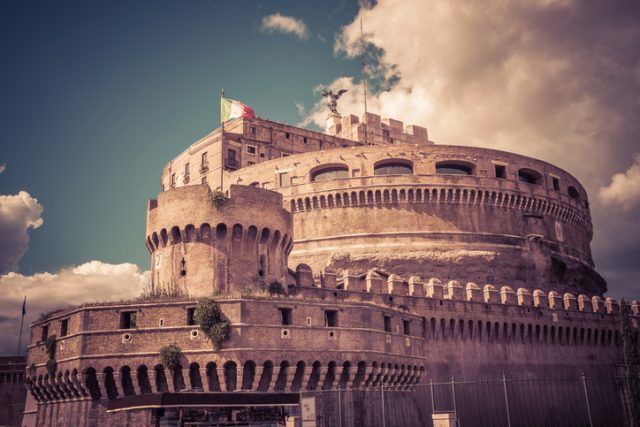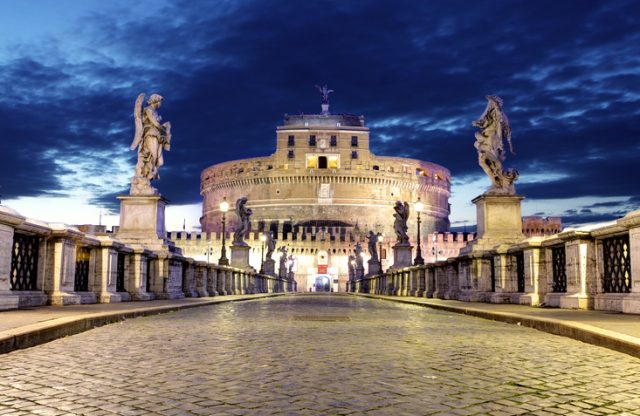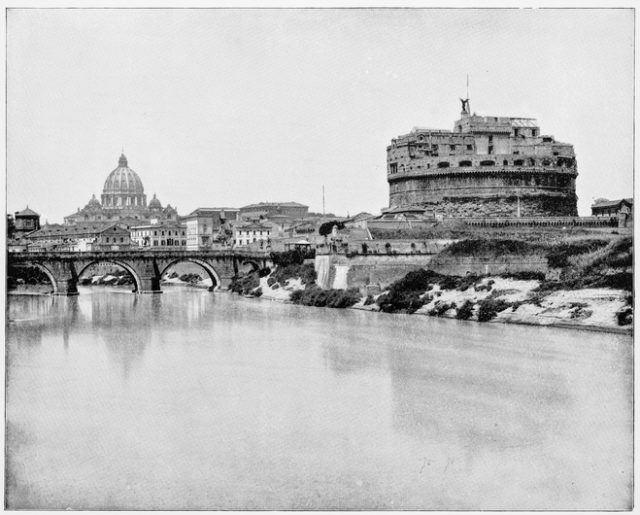Historic buildings and ancient ruins are a common sight in the eternal city of Rome. This centuries-old castle on the right bank of the Tiber River is very hard to miss, especially when headed to the Vatican. The massive structure is one of the landmarks of the city. Today, it is known as Castel Sant’Angelo. However, that wasn’t its original name, nor its original purpose.
Initially, the site was chosen by the Roman Emperor Hadrian as the site of the mausoleum for himself and his family. Construction on the project began in 123 A.D., supervised by the Emperor himself. The design of the Emperor’s mausoleum was influenced by the giant tomb built by the first Roman emperor, the Mausoleum of Augustus.
The cylindrical colonnaded mausoleum was built in the center of a square base, adorned on top of it with a golden statue of Emperor Hadrian driving a quadriga, which was the symbol of victory. The Emperor also built the Pons Aelius (the Bridge of Hadrian) over the river to enable easy access from the other side of the city. However, Hadrian died shortly before construction was completed.

His successor, Emperor Antoninus Pius, decided to finish Hadrian’s project. In 139 A.D. it was completed, and the funerary urn of Emperor Hadrian was finally brought to the mausoleum. The building was generally known as the “Hadrianeum” and also served as a burial site for his wife Sabina and Lucius Aelius, their adopted son, as well as each of the succeeding emperors and their families. The last Roman emperor buried in the mausoleum was Caracalla.
With his death, the turbulent times of Hadrian’s mausoleum commenced. Since it no longer served as an emperor’s tomb, towards the end of the 3rd century, it was fortified and had the role of defending the city from invaders. In the 5th century, Rome was attacked by the Goths, who plundered the mausoleum, completely destroying the urns of the emperors in the process.

Then, towards the end of the 6th century, during a devastating plague in Rome, Pope Gregory the Great had a vision that would change the name of the building. As the Pope prayed for the end of the plague, he said the Archangel Michael miraculously appeared to him on top of the building, sheathing his sword, as a sign that his prayers had been heard and the disease would finally be stopped. After this, the Pope renamed the Mausoleum of Hadrian to be Castel Sant’Angelo (Castle of the Holy Angel) and Pons Aelius to Ponte Sant’Angelo.
Over the following centuries, the castle became the property of the church and served mostly as a refuge for various popes during the invasions of the city. The castle was constantly improved by new additions, but the most important was the construction of the secret passageway called Passetto di Borgo in 1277. It was commissioned by Pope Nicholas III and connects the castle to the Vatican, offering a safe escape for the popes.

The passageway saved the lives of at least two popes. Pope Alexander VI used it when Rome was attacked by Charles VIII in 1494, and Pope Clement VII crossed it during the Sack of Rome in 1527. (Passetto di Borgo plays an important role in one of Dan Brown’s bestsellers, Angels and Demons.) In the 16th century, the Pope commissioned Raffaello da Montelupo to create a marble statue of Saint Michael and placed it on top of the castle, which was later replaced by a bronze statue by the Flemish sculptor Peter Anton von Verschaffelt. The original angel is on display inside the courtyard of the castle.
Related story from us: In 1620s Rome, the best parties by far were thrown at the Villa Borghese
The popes used the castle not only as their residence but also as a prison. In 1901, the castle was restored and turned into a museum. Some of the highlights are the lavishly decorated papal apartments, especially one room believed to be decorated with frescoes and paintings by Raphael himself, the museum of military history and impressive Renaissance paintings. Keeping in mind that it was once the tallest building in the city, it is no surprise that Castel Sant’Angelo has some of the most breathtaking views of Rome.
